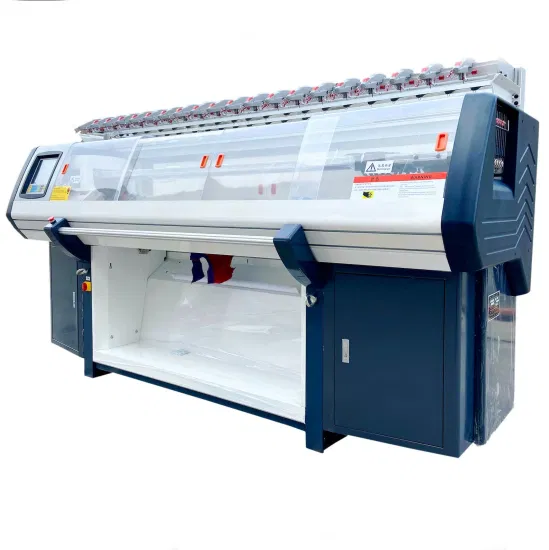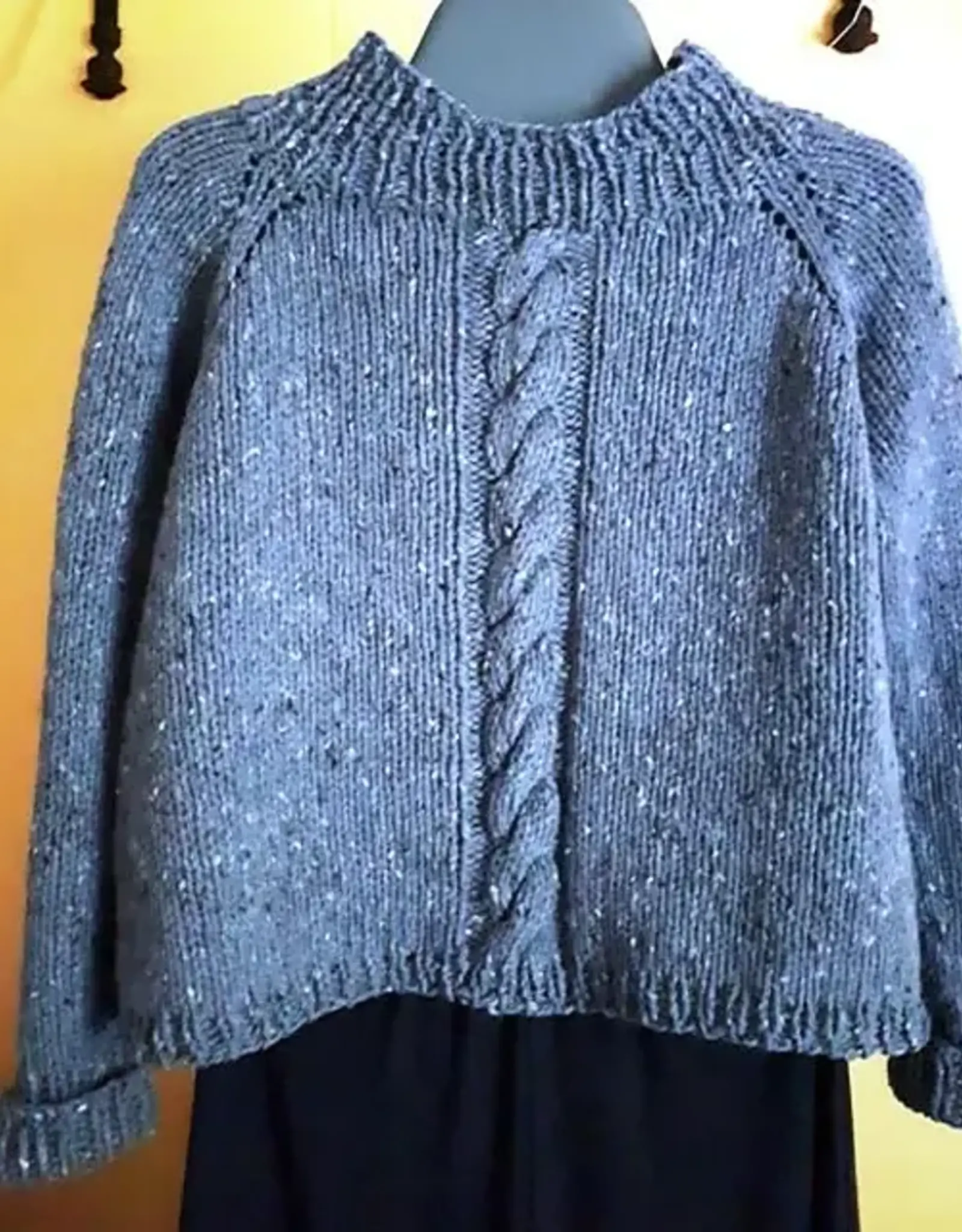Knitting a multigauge sweater typically requires more time due to its complex patterns. The diverse stitch sizes create a unique texture that demands attention to detail.
A multigauge sweater is a testament to the knitter’s skill, blending different yarn weights and needle sizes to craft intricate designs. The varied stitch gauges not only add visual depth but also require precise calculation and adjustments throughout the knitting process.

As knitters tackle these challenges, the extra time invested in creating a multigauge piece ensures a high-quality and distinctive garment. For those with a passion for knitting, the complexity of a multigauge sweater offers a satisfying project that pushes the boundaries of their craft. The end result is a cozy, stylish, and personalized piece that stands out in any wardrobe.
Unraveling The Appeal Of Multigauge Sweaters
The allure of multigauge sweaters lies in their varied textures. Knitters blend different stitch sizes to create a unique fabric landscape. This landscape allows for a play of shadows and highlights on the sweater, providing a tactile experience as well as visual intrigue. Unique patterns and designs come alive with this technique. Complexity increases as the gauges shift, demanding more time and skill from the knitter. Each piece is not just a garment but a crafted work of art, often reflecting the personality of the creator. The final result is a one-of-a-kind fashion statement, celebrated by trendsetters.
The Basics Of Knitting Gauge
Knitting gauge is crucial for sweater-making. It tells you the size of your stitches. Good gauge means your sweater fits right. Stitch size matters a lot in knitting. To check gauge, you knit a small sample first. Consistent stitch size makes your sweater look nice. If the gauge is off, your sweater may be too big or small. Measuring gauge helps save time. You won’t have to redo your work. Keep practicing to improve your knitting gauge.
Contrasting Multigauge And Single Gauge Knitting
Knitting with single gauge is like a smooth road. It uses one yarn size. It is straightforward and quick. Large projects finish faster. Multigauge patterns, on the other hand, are intricate. They combine different yarn weights. This mix brings texture and shape to sweaters. Skill and patience are key. Each stitch may vary, needing focus. The complexity lies in the transition between gauges. This creates distinctive designs. But it requires more time to master. Knitters will spend additional hours crafting a multigauge sweater. Yet, the result is a unique piece worth the effort.
Why Multigauge Knitting Takes Longer
Multigauge knitting demands patience due to the constant switching between needle sizes. This process is essential to achieve the desired fabric texture. Each needle adjustment requires the knitter to adapt their technique and tension. The complexities do not stop there. Varying stitches can be tricky to manage, as each stitch type may need a different gauge. This means that knitters must stay extra attentive to their work. The need for consistent stitch quality across different gauges further prolongs the knitting process.
Patience And Precision In Multigauge Knitting
Multigauge knitting requires a keen eye for detail. This technique involves using different needle sizes within one project. It’s not just about choosing the right needles. You must also monitor each stitch. A tight grip and consistent tension keep stitches even. This means taking your time with each row. Knitters must be patient, as hurrying can lead to mistakes. The process is slower than single gauge knitting. Yet, the end result of a multigauge sweater is truly unique. Each piece displays the knitter’s dedication and skill.

Credit: www.stringtheoryyarn.ca
Tools Of The Trade
Knitters need different needles for multigauge sweater projects. A variety of sizes ensures precision across various stitch sizes. Interchangeable needle sets offer versatility and save space. Circular needles are a must for seamless patterns. Stitch markers help in noting pattern changes. Stitch holders are crucial for pausing work on sections. Measuring tapes and gauges assess stitch size and sweater dimensions. Proper tools keep projects organized and consistent.
Challenges In Multigauge Sweater Construction
Knitting a multigauge sweater poses unique challenges. Crafters must ensure consistent tension across different stitch sizes. It’s like a puzzle, where each piece must fit perfectly. Otherwise, the sweater can warp or lose shape. Seaming different fabrics requires extra care. Aligning stitches with varying thickness is tricky. Stitches may not line up, leading to a bumpy seam or discomfort.
Time Investment In Mastering Multigauge Techniques
Mastering multigauge techniques demands patience and time. Knitters need to practice regularly to improve. Each stitch and pattern varies in complexity. Starting simpler projects help beginners. Consistent practice leads to better speed and skill. Knitting a sweater with multiple gauges becomes easier over time. Trials and errors are part of the journey. Enthusiasts should not get discouraged.
- Commitment to learning is crucial.
- Guides and tutorials can offer valuable tips.
- Patience during the learning phase is key.
Improving Efficiency In Multigauge Knitting
Multigauge sweater knitting may seem daunting due to its complexity. Seeking advanced techniques is crucial for efficiency. First, leverage automated knitting machines, which work faster than manual methods. Combining various yarns can reduce knitting time significantly. For instance, using a bulkier yarn for larger gauges speeds up the process. Implementing double-bed machines that handle multiple gauges simultaneously streamlines tasks. Lastly, routinely maintaining equipment prevents unexpected delays. On the front of time-saving tips, preparation stands paramount. Always have materials sorted and patterns ready before starting. Consistent tension throughout the knitting ensures uniformity and reduces rework. Batch processing smaller sections of the garment can also cut down on total knitting time. Multigauge projects are time intensive, but employing these strategies makes them more manageable.
The Satisfaction Of Completing A Multigauge Sweater
Knitters understand the thrill of completing a multigauge sweater. It’s not just an item; it’s a showcase of detailed skill and patience. The joy shines brightest upon binding off the final stitch. Crafting each piece of the pattern demonstrates dedication to the art. As the sweater takes shape, the crafter’s pride swells with each row. This is not just knitting; it’s bringing yarn to life in the form of cozy warmth. The final product stands as a testament to commitment and love for craftsmanship. Such projects require more time, but the satisfaction derived is unparalleled. Gleaming with intricate designs, the multigauge sweater represents a journey of creativity and precision. Each stitch reflects a moment spent in focused creation. Ultimately, wearing it offers a special kind of joy, one that comes from sporting a self-made masterpiece.
Embracing The Slow Fashion Movement With Multigauge Knitting
Multigauge knitting is a craft celebrated for its beautiful complexity and time-consuming nature. This type of knitting involves multiple needle sizes, which leads to distinctive textures and patterns. Each piece becomes a symbol of patience and dedication as it takes more time to create than single-gauge work. Crafters are now adoptive of sustainable methods, embracing the slow fashion movement. They choose eco-friendly materials and ethical practices. Through multigauge knitting, a mindful approach to fashion is promoted. Knitters enjoy a serene and thoughtful process, linking every stitch with the slow fashion ethos. This holistic practice not only reduces waste, but also enhances the creative experience.

Credit: www.machinio.com

Credit: m.made-in-china.com
Frequently Asked Questions For Multigauge Sweater Tooks More Time For Knitting
Why Does Knitting A Multigauge Sweater Take Longer?
Multigauge sweater projects often take longer due to the intricate stitching patterns and varying yarn thicknesses which require frequent needle changes and careful attention to detail.
What’s Unique About Multigauge Sweater Knitting?
Multigauge knitting utilizes different yarn weights or stitch sizes within a single garment, creating unique textures and patterns that stand out from traditional, uniform knits.
How To Choose Yarn For Multigauge Knitting?
Selecting yarn for multigauge knitting involves considering the desired texture and drape, ensuring compatible fiber types, and choosing colors that highlight the varying stitch patterns.
Can Beginners Try Multigauge Sweater Patterns?
Beginners can tackle multigauge sweater patterns by starting with simpler designs, practicing gauge changes before starting, and being patient with the learning curve involved.
What Are The Benefits Of Multigauge Knitting?
Multigauge knitting offers creative freedom to play with textures, forms fitting and unique designs, and it may also utilize leftover yarns from other projects effectively.
How To Estimate Knitting Time For Multigauge Sweaters?
Estimate multigauge knitting time by evaluating the pattern’s complexity, your knitting speed, the needle changes required, and factoring in additional time for potential corrections.
Are Multigauge Sweaters More Stylish Than Single Gauge?
Multigauge sweaters often feature a blend of textures and patterns, providing a distinct, stylish look that stands out compared to the uniformity of single gauge knits.
Conclusion
Embracing the art of multigauge sweater knitting can indeed test your patience, but the outcome is unrivaled in texture and quality. These cozy creations demand time but reward knitters with unparalleled satisfaction. So, grab your needles, savor the process, and watch as your efforts weave into warmth.
